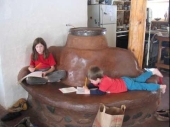ronie wrote:
Perhaps you didn't understand. It is a rocket cooker and i used it for two years to cook with and smoke foods. It would not be applicable to this thread as it is an outdoor stove.
Correction understood. Perhaps I should have used more words, or left it to others to read your own work. Yours is more the size, and probably very like the output of the smallest of those marine stoves (I'll bet with less smoke and fuel use? I doubt these little commercial stoves are "re-burners" which cycle the smoke through for complete combustion. In fact, I'll bet the camping ones are pretty dirty.)
What I meant by "unpolished" was that the implementation wasn't worked through enough for this kind of vehicle application, as you said (Nor was my tiny experimental job). Like those great little marine stoves, it needs to be fastened down, made from better materials (I'm toying with second-hand sheet metal, and won't ever even try using aluminum or galvanized, and won't consider anything even close to operational status if it isn't of good solid steel)
So, what we're looking for (myself, anyway) is something no bigger than your outdoor burner, or the small marine stoves, that's secure and heavy duty enough to serve. I suspect a rocket burner would need more attention paid to ash or fuel spill-out of the intake horizontal of the "
L" than any of the "can-based" ones we see out there.
Note my observations about the entire small thing getting hot enough that any fuel stored in a chute will ignite; so it's not continuous self-feed, but rather continuous tending.
I also still think some sort of heat exchanger on the uptake pipe can be used to get more of the heat out of it. Experimentation will show if there's enough draft to drive it through some sort of concentric can or maybe a donut of stove pipe.
The rocket stove will produce the energy, and it'll get hot itself, but I believe lots of heat will go out the pipe, if some extra air surface area isn't offered to transfer heat to the room air.
Hmmm... Another idea to that: if it's cold you'll want such additional heat, but if it's a hot day you might want to remove the heat exchanger and run straight pipe outside immediately after the hot plate? Experimentation...
I hadn't thought about adding mass. Some household woodstoves have had removable tile/bricks for bedwarmers, and many have fire brick liners which will act as heat sink. If cartage weight isn't an issue (truck or stationary as opposed to going along with a tent), something could be arranged.
If nothing else, firebricks to set on the hotplate after cooking is done.
It'd be lovely to cast it out of refractory... Insulate the burn tunnel a bit to help it start drafting, but for a vehicle or stationary use, make it a massive heat sink.





 1
1

















































